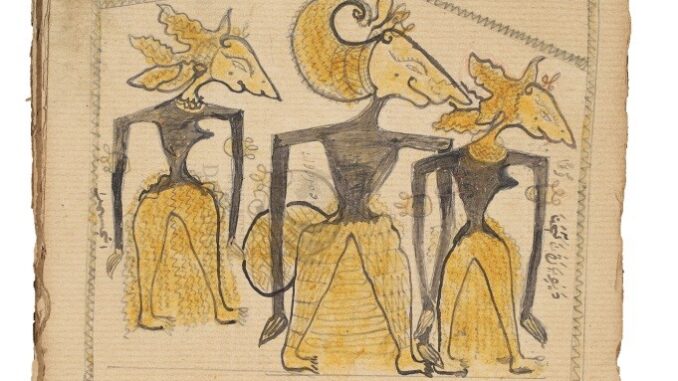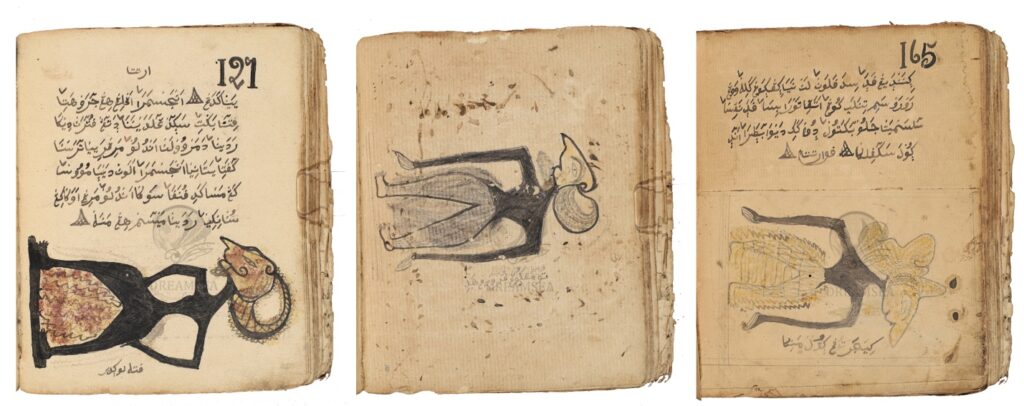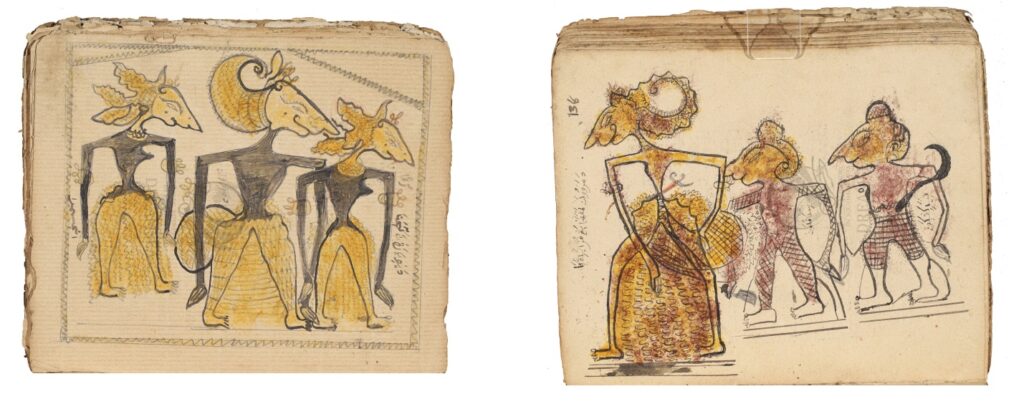
The Serat Damar Wulan discussed here is an old manuscript owned by Bapak Sucipto in Banyuwangi at the tip of East Java. DREASMEA has digitized the manuscript in March 2019 and it has been given the number DS 0038 00001. The manuscript is interesting because, unlike other manuscripts of the Damar Wulan story, it is written in pegon script rather than Javanese script used in most other manuscripts of the poetic and prose versions of this text. Pegon script is Arabic script adapted to the requirements of the Javanese language. The simple fact that a pegon version of the Serat Damar Wulan exists shows that a transformation process from Hindu-Buddhist culture to that of Islam has taken place (Lutfi, 2020: 81).
The Serat Damar Wulan is an epic poem and a romantic tale at the same time. The story is a typical “lakon” and thus a kind of script that may be used for a Javanese theatrical performance. Up to the present, we do not know when it was first created or who its author may have been. Some say that it was created by a certain Carik Bajra, who was a court poet at the Kartasura palace in the early 18th century. Another scholar is convinced it was written by a certain Pangeran Pekik during the rule of Sultan Agung in Central Java in 1620 (Coster-Wijsman, 1953: 153)
The hero, Damar Wulan, was a grass cutter who also took care of the horses of Vizir Logender in the East Javanese Kingdom of Majapahit. Because of his extraordinary good looks and his skill and intelligence, he became the vizir’s trusted servant. Anjasmara, the vizir’s daughter fell in love with him but was thwarted in her desire because the maiden Queen of Majapahit, Ratu Kencana Wungu (Ratu Kenya), ordered him to subdue her enemy, Menak Jingga the ruler of Blambangan, who was plotting to rise against Majapahit. The handsome Damar Wulan managed to draw the attention of Menak Jingga’s concubines, Dewi Wahita and Dewi Puyengan and with their help, he acquired Menak Jingga’s supernatural weapon, Gada Wesi Kuning and he defeated Menak Jingga. Having returned to Majapahit, he married Anjasmara and, with her permission, he also married the queen and he became King of Majapahit and ruled under the title Brawijaya.
The manuscript of the Serat Damar Wulan (DS 0038 00001) under discussion here is written very clearly and not at all hard to read. However, in some places, the script has become faded and therefore hard to read. The manuscript was written on Wednesday, 4 Suro in the year Ha, and consists of 550 pages. Unfortunately, the covers and some pages at the start have become lost. 21 Pages are illustrated.

The illustrations in the manuscript were made in what is commonly called the wayang style as it was used in Java since the end of the Hindu period. They depict the major characters in the Damar Wulan story as well as their supporters and antagonists. They are the same characters as found in stories of the Javanese shadow theatre (wayang) such as chivalrous heroes, villains, priests, clowns and such more. Although the characters in the story were transformed into these figures to make them match the wayang repertoire, this did not change the way the story runs. The illustrations are coloured to make them more attractive and for easy reference, their names were provided in the illustrations.

The characters depicted in the pictures include, of course, Damar Wulan himself, but also Prabu Kenya (Dewi Kencana Wungu), Anjasmara, Menak Jingga, Patih Logender, Layang Setra, Layang Kumitir, Sida Palon (Sabdo Palon), Naya Genggong, Dewi Wahita, Dewi Puyengan, Kot Buta, Angkat Buta, Ranggalawe, Patih Sangga Langit, Watangan, Buntaran, Arya Sasimping, Tumenggung Purwa Hadi, Ajar Tunggul Manik, Menak Sena, Bupati Daha, Bupati Cirebon, and Bupati Semarang. In short, all the characters that play a role in the story are depicted.

An interesting feature of these illustrations is that they are extremely simple, both in the way, they were drawn as well as in the way colours were added to them. None of the illustrations actually picture a scene from the story but only the characters themselves and they may be divided as to their number on one page as can be seen in illustrations 1-3. Also no distinguishing elements like crowns, weapons, or specific ways of dress have been clearly indicated in the pictures. Moreover, only three colours have been used: black, yellow and brown. The whole manuscript, and also the illustrations, show that it was most likely made by a modest person and the illustrations were probably made by the scribe. Nevertheless, the illustrations in the manuscript are important because they clearly indicate that this kind of manuscripts and texts were not only produced among palace circles but also among everyday society in the farthest corner of East Java.
Bibliography
- Coster-Wijsman, L.M. 1953. “Illustrations in a Javanese Manuscript.” Bijdragen tot de. Taal-, Land- en Volkenkunde 109 (2): 153–163.
- Lutfi, Mochtar. 2020. “Transformasi Tokoh Wayang dalam Naskah Serat Damarwulan.” Mozaik Humaniora 20 (1): 79-88.

Lecturer of PGRI University of Banyuwangi,
Millennial Mocoan Lontar Yusup Community,
Member of Manassa

Leave a Reply